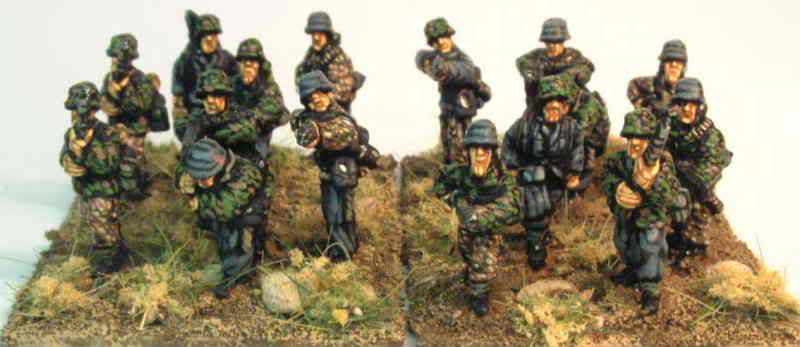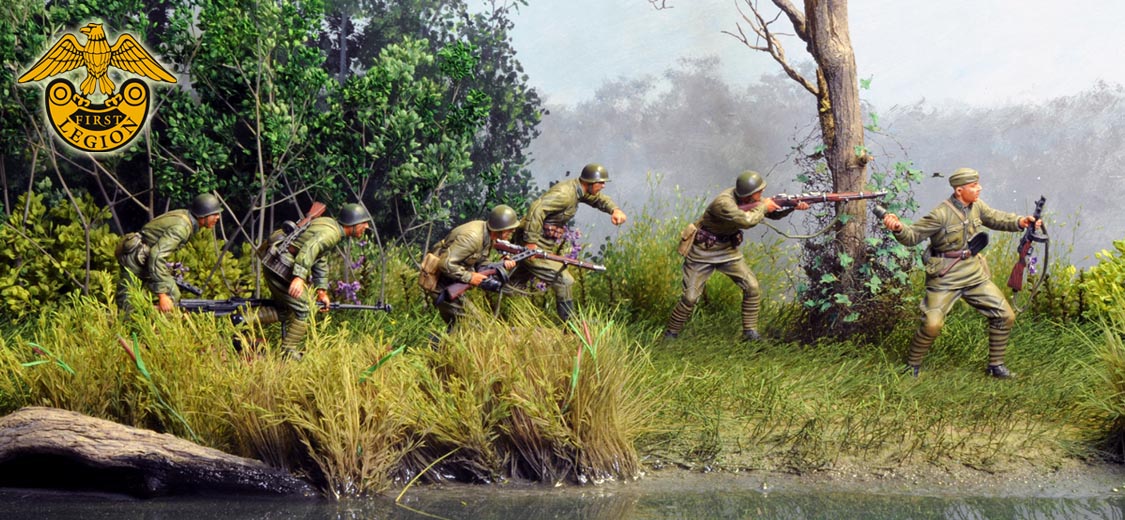SS men confer with GeneralHenning Linden during the capture of the Dachau concentration camp. Pictured from left to right: SS aide, camp leader Untersturmführer Heinrich Wicker (mostly hidden by the aide),Paul M. G. Lévy, a Belgian journalist (person with helmet looking to his left), Dr. Victor Maurer (back), Gen. Henning Linden (person with helmet, looking to his right) and some U.S. soldiers.Just before the soldiers entered the complex, they found thirty-nine railway boxcars containing some two-thousand skeletal corpses. Brain tissue was splattered on the ground from one victim found nearby with a crushed skull. The smell of decaying bodies and human excrement, and the sight of naked, emaciated bodies induced vomiting, crying, disbelief and rage in the advancing troops. Advancing soldiers from H Company, 22d Regiment used a loudspeaker to call on the SS to surrender, "but they wouldn’t." The American troops were then fired on by machine gunners in a guard tower and a building.
According to Harold Marcuse, the camp commander SS-Hauptsturmführer Martin Weiss, together with the camp guards and the SS garrisons, had fled the camp before the arrival of U.S. troops. SS-Untersturmführer Heinrich Wicker (killed after the surrender) was left in charge and had roughly 560 personnel at his disposal; these came from conscripted inmates of the SS disciplinary prison inside the Dachau concentration camp and Hungarian Waffen-SS troops.

On 29 April 1945, Dachau was surrendered to Brigadier General Henning Linden of the 42nd Infantry Division of the U.S. Army by Untersturmführer Wicker. According to Linden, he arrived at the Command Post in Dachau at about 15:00, and then proceeded to make his way across the Amper River to the site of the complex approximately one half kilometer south of the bridge he crossed.He proceeded to take control of the camp under some tumult; thereafter, he toured the camp with a group of reporters (including Marguerite Higgins). A description of the surrender appears in Brig. Gen. Henning Linden's memorandum to Major Gen. Harry J. Collins, entitled "Report on Surrender of Dachau Concentration Camp":
Military historian Earl Ziemke describes the event:
Sparks account
Lt. Col. Felix L. Sparks, a battalion commander of the 157th Infantry Regiment, 45th Infantry Division, Seventh United States Army wrote about the incident. Sparks watched as about 50 German prisoners captured by the 157th Infantry Regiment were confined in an area that had been used for storing coal. The area was partially enclosed by an L-shaped masonry wall about 8 ft (2.4 m) high and next to a hospital. The German POWs were watched over by a machine gun team from Company I. He left those men behind to head towards the center of the camp where there were SS who had not yet surrendered; he had only gone a short distance when he heard a soldier yell "They're trying to get away!" and then machine gunfire coming from the area he had just left. He ran back and kicked a 19-year-old soldier nicknamed "Birdeye" who was manning the machine gun and who had killed about 12 of the prisoners and wounded several more.[15] The gunner, who was crying hysterically, said that the prisoners had tried to escape. Sparks said that he doubted the story; Sparks placed an NCO on the gun before resuming his journey towards the center of the camp.[16] Sparks further stated:
Sparks watched as about 50 German prisoners captured by the 157th Infantry Regiment were confined in an area that had been used for storing coal. The area was partially enclosed by an L-shaped masonry wall about 8 ft (2.4 m) high and next to a hospital. The German POWs were watched over by a machine gun team from Company I. He left those men behind to head towards the center of the camp where there were SS who had not yet surrendered; he had only gone a short distance when he heard a soldier yell "They're trying to get away!" and then machine gunfire coming from the area he had just left. He ran back and kicked a 19-year-old soldier nicknamed "Birdeye" who was manning the machine gun and who had killed about 12 of the prisoners and wounded several more.[15] The gunner, who was crying hysterically, said that the prisoners had tried to escape. Sparks said that he doubted the story; Sparks placed an NCO on the gun before resuming his journey towards the center of the camp.[16] Sparks further stated:
 Sparks watched as about 50 German prisoners captured by the 157th Infantry Regiment were confined in an area that had been used for storing coal. The area was partially enclosed by an L-shaped masonry wall about 8 ft (2.4 m) high and next to a hospital. The German POWs were watched over by a machine gun team from Company I. He left those men behind to head towards the center of the camp where there were SS who had not yet surrendered; he had only gone a short distance when he heard a soldier yell "They're trying to get away!" and then machine gunfire coming from the area he had just left. He ran back and kicked a 19-year-old soldier nicknamed "Birdeye" who was manning the machine gun and who had killed about 12 of the prisoners and wounded several more.[15] The gunner, who was crying hysterically, said that the prisoners had tried to escape. Sparks said that he doubted the story; Sparks placed an NCO on the gun before resuming his journey towards the center of the camp.[16] Sparks further stated:
Sparks watched as about 50 German prisoners captured by the 157th Infantry Regiment were confined in an area that had been used for storing coal. The area was partially enclosed by an L-shaped masonry wall about 8 ft (2.4 m) high and next to a hospital. The German POWs were watched over by a machine gun team from Company I. He left those men behind to head towards the center of the camp where there were SS who had not yet surrendered; he had only gone a short distance when he heard a soldier yell "They're trying to get away!" and then machine gunfire coming from the area he had just left. He ran back and kicked a 19-year-old soldier nicknamed "Birdeye" who was manning the machine gun and who had killed about 12 of the prisoners and wounded several more.[15] The gunner, who was crying hysterically, said that the prisoners had tried to escape. Sparks said that he doubted the story; Sparks placed an NCO on the gun before resuming his journey towards the center of the camp.[16] Sparks further stated:
In the U.S. military "Investigation of Alleged Mistreatment of German Guards at Dachau" conducted by Lt. Col. Joseph Whitaker, the account given by Howard Buechner (then a first lieutenant in the United States Army and medical officer with the 3rd Battalion of the 157th Infantry), to Whitaker on 5 May 1945 did not contradict the Sparks account. He said that around 16:00 he arrived in the yard where the German soldiers had been shot, and that he "saw 15 or 16 dead and wounded German soldiers lying along the wall." He noted that some of the wounded soldiers were still moving but he did not examine any of them. He further told Whitaker that he did not know the soldier guarding the yard or which company he was from.[17]
According to Buechner's 1986 book, Dachau: The Hour of the Avenger : An Eyewitness Account,] U.S. forces killed 520 German soldiers, including 346 killed on the orders of 1st Lt. Jack Bushyhead, in an alleged mass execution in the coalyard several hours after the first hospital shooting. Buechner did not witness the alleged incident, however, and there was no mention of a second shooting in the official investigation report.[17] David L. Israel disputed this account in his book The Day the Thunderbird Cried:
Abram Sachar reported, "Some of the Nazis were rounded up and summarily executed along with the guard dogs."
According to Jürgen Zarusky (originally published in a 1997 article in Dachauer Hefte), 16 SS men were shot in the coalyard (one more killed by a camp inmate), 17 in Tower B, and perhaps a few more killed by U.S. soldiers in the incident. Anywhere from a few to 25 or 50 more were killed by furious inmates. Zarusky's research makes use of the detailed interrogation records contained in Whitaker's official May 1945 investigation report, which became accessible in 1992, as well as a collection of documents compiled by General Henning Linden's son.
After the hospital shooting was stopped, some of the U.S. soldiers allegedly gave a number of handguns to the now-liberated inmates. It has been claimed by eyewitnesses that the freed inmates tortured and killed a number of captured German troops, in retaliation for their treatment in the camp. The same witnesses claim that many of the German soldiers killed by the inmates were beaten to death with shovels and other tools. A number of Kapo prisoner-guards were also killed, torn apart by the inmates.
Lt. Col. Joseph Whitaker, the Seventh Army's Assistant Inspector General, was subsequently ordered to investigate after witnesses came forward testifying about the killings. He issued a report on 8 June 1945, called the "Investigation of Alleged Mistreatment of German Guards at Dachau" and also known as "the I.G. Report". In 1991, an archived copy was found in the National Archives in Washington, D.C. and was made public.[17]
Whitaker reported that close to the back entrance to the camp Lt. William P. Walsh, commander of Company "I", 157th Infantry, shot four German soldiers in a box car who had surrendered to him. Pvt. Albert C. Pruitt then climbed into the box car and performed a coup de grâce on the wounded men.[17]
After he had entered the camp Walsh, along with Lt. Jack Bushyhead, the executive officer of Company "I" organized the segregation of POWs into those who were members of the Wehrmacht and those who were in the SS. The SS were marched into a separate enclosure and were shot by members of "I" Company with several different types of weapons.[17]
The investigation resulted in the U.S. Military considering courts-martial against those involved, including the Battalion commander Lt. Col. Felix Sparks, while Col. Howard Buechner was cited in the report for dereliction of duty for not giving the wounded SS men in the coal yard medical aid.[17] However, General George S. Patton, the recently appointed military governor of Bavaria, chose to dismiss the charges. Therefore, the witnesses to the killings were never cross-examined in court.[16]
The reprisals are portrayed in the 2010 psychological thriller film Shutter Island. The film's protagonist, Edward "Teddy" Daniels (Leonardo DiCaprio) is an veteran of the war who experiences visions of Dachau, the reprisals and his involvement in them.


JcOg~~60_12.JPG)








BQv4+Nwt8w~~60_12.JPG)



